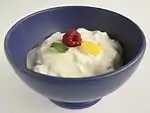Dhau
Dhau (Nepal Bhasa: धौ) is yogurt prepared by Newars of Nepal. It is a milk product made by bacterial fermentation of milk. It is usually made in clay pots and plastic cups.

Mandatory dessert
Dhau along with chopped fruits are the staple dessert at Newar feasts. At the end of the meal, a server walks down the line of guests ladling out two portions of yogurt from a clay pot. Dhau mixed with baji (beaten rice) is also a popular snack and ceremonial food.[1]
The most famous and delicious variety of dhau is juju dhau, which is known for its rich taste and thick consistency. Juju dhau literally means "king yogurt" in Nepal Bhasa. It is a specialty of the town of Bhaktapur.
Ritual significance
In addition to being an important ingredient in Newar cuisine, dhau has ritual significance. Dhau denotes purity, and it is a compulsory item during auspicious ceremonies, local festivals, marriage rituals, religious occasions and family gatherings. During the auspicious Sagan ceremony, it is offered to the family members who take a dab and put it on the temple.[2]
When someone goes away or returns from a long journey, clay pots containing dhau are put on water pitchers and placed on either side of the doorway for good fortune.
During ritual bathing ceremonies of deities, dhau is one of the items poured over the image. An important ceremony associated with Jana Baha Dyah is known as Dhalin Luigu (धलिं लुइगु), which means pouring yogurt. The deity is known in Sanskrit as Aryavalokitesvara (Sacred Avalokiteśvara), and also White Machhendranath.[3]
References
- Gutschow, Niels; Michaels, Axel (2008). Bel-Frucht und Lendentuch: Mädchen und Jungen in Bhaktapur, Nepal. Otto Harrassowitz Verlag. p. 39. ISBN 9783447057523.
- Löwdin, Per (1985). Food ritual and society among the Newars. Uppsala University. p. 108. ISBN 9789150605938.
- "Bathing ceremony of Janabahaa Dyo". The Himalayan Times. 1 January 2012. Retrieved 15 June 2013.
